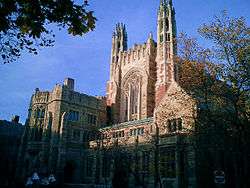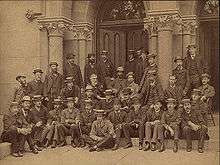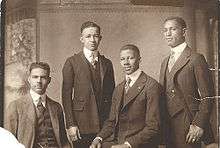Yale Law School
| Yale Law School | |
|---|---|
|
Coat of arms of the School | |
| Parent school | Yale University |
| Established | 1824 |
| School type | Private |
| Endowment | $1.2 billion |
| Parent endowment | $25.6 billion[1] |
| Dean | Robert C. Post |
| Location |
New Haven, Connecticut, United States 41°18′43″N 72°55′41″W / 41.312°N 72.928°WCoordinates: 41°18′43″N 72°55′41″W / 41.312°N 72.928°W |
| Enrollment | 629[2] |
| Faculty | 149[2] |
| USNWR ranking | 1[3] |
| Bar pass rate | 96.3%[2] |
| Website | www.law.yale.edu |
| ABA profile | Yale Law School Profile |
|
| |
Yale Law School (often referred to as Yale Law or YLS) is the law school of Yale University, located in New Haven, Connecticut, United States. The school's small size and prestige make its admissions process the most selective of any law school in the United States.[4][5] Yale has the lowest acceptance rate among all law schools.[5] Roughly 8 in 10 admits ultimately matriculate,[6] which marks the best yield rate among the top U.S. law schools.[5][7] Established in 1824, Yale Law offers the J.D., LL.M., J.S.D., M.S.L., and Ph.D. degrees in law. Yale Law has been ranked the number one law school in the country by U.S. News and World Report every year since the magazine began publishing law school rankings, through 2016.[8]
Yale Law has produced a significant number of luminaries in law and politics, including United States presidents Gerald Ford and Bill Clinton. The law school's Lillian Goldman Law Library has been memorialized as the meeting place of Bill Clinton and fellow student, Hillary Clinton, the 67th Secretary of State and Democratic nominee for president of the United States. Former president William Howard Taft was a professor of constitutional law at Yale Law School from 1913 until he resigned to become chief justice of the United States in 1921. Alumni also include current United States Supreme Court associate justices Clarence Thomas, Samuel Alito and Sonia Sotomayor, as well as a number of former justices, including Abe Fortas, Potter Stewart and Byron White; several heads of state around the world, including Karl Carstens, the fifth president of Germany, and Jose P. Laurel, the third president of the Republic of the Philippines; four current U.S. senators, and the current deans of five of the top fourteen-ranked law schools in the United States: Yale, Harvard, Virginia, Cornell, and Georgetown.
Each class in Yale Law's three-year J.D. program enrolls approximately 200 students. The school's law library, the Lillian Goldman Law Library, is one of the largest law libraries in the world. Yale's flagship law review is the Yale Law Journal.
According to Yale Law School's 2014 ABA-required disclosures, 88.3% of the Class of 2014 obtained full-time, long-term, JD-required or JD-advantage employment nine months after graduation, excluding solo practitioners.[9]
Culture

The institution is known for its scholarly orientation; a relatively large number of its graduates (9%) choose careers in academia within five years of graduation, while a relatively low number (46%) choose to work in law firms five years after graduation.[10] Another feature of Yale Law's culture since the 1930s, among both faculty and student graduates, has been an emphasis on the importance of spending at least a few years in government service.[11] A similar emphasis has long been placed on service as a judicial law clerk upon graduation.[12] Its 7.6:1 student-to-faculty ratio is the third lowest among U.S. law schools.[13]
Yale Law does not have a traditional grading system, a consequence of student unrest in the late 1960s.[14] Instead, it grades first-semester first-year students on a simple Credit/No Credit system. For their remaining two-and-a-half years, students are graded on an Honors/Pass/Low Pass/Fail system. Similarly, the school does not rank its students. It is also notable for having only a single semester of required classes, instead of the full year most U.S. schools require. Unusually, and as a result of unique Connecticut State court rules, Yale Law allows first-year students to represent clients through one of its numerous clinics; other law schools typically offer this opportunity only to second- and third-year students.
Students publish nine law journals that, unlike those at most other schools, mostly accept student editors without a competition. The only exception is YLS's flagship journal, the Yale Law Journal, which holds a two-part admissions competition each spring, consisting of a four or five-hour "bluebooking exam," followed by a traditional writing competition. Although the Journal identifies a target maximum number of members to accept each year, it is not a firm number. Other leading student-edited publications include the Yale Law and Policy Review, the Yale Journal on Regulation, the Yale Journal of Law and Technology, and the Yale Journal of International Law.
In November 2013, it was announced that a $25 million donation would bring student dormitory living back onto campus, with renovations to begin in 2018.[15]
Rankings and reputation
Yale Law has been ranked the number one law school in the country by U.S. News and World Report in every year in which the magazine has published law school rankings.[16] Among U.S. law schools, Yale has the lowest acceptance rate and the highest yield rate—whereas less than 10% of applicants are admitted, about 80% of those who are accepted ultimately enroll, either in the Fall following their acceptance or after a deferral.[17][18][19] It is currently ranked as the second best law school in U.S (behind Harvard) and fourth in the world by the 2016 QS Rankings.[20] The school also saw a greater percentage of its students go on to become Supreme Court clerks between the 2000 and 2010 terms than any other law school, more than double the percentage of the second-highest law school (Harvard Law School).[21] In addition to producing the most Supreme Court clerks per capita, Yale saw a greater percentage of its graduates accept federal clerkships among the United States Courts of Appeal and District Courts than any other law school; more than one third of Yale graduates go on to clerk for a federal judge.[22][23] Additionally, a 2010 survey of "scholarly impact," measured by per capita citations to faculty scholarship, found Yale's faculty to be the most cited law school faculty in the United States.[24]
History
The School began in the New Haven law office of Seth P. Staples in the 1800s, who began training lawyers. By 1810 he was operating a law school. He took on a former student, Samuel J. Hitchcock as a law partner, and Hitchcock became the proprietor of the New Haven Law School, joined by David Daggett in 1824. (The Yale Law School shield, shown at the upper right of this page, shows staples and a rampant dog, representing Seth Staples and David Daggett.) The school's affiliation with Yale began in the mid-1820s and in 1843, the school's students began receiving Yale degrees.[25]



Legal Realism movement
Beginning in this period, a special relationship or connection developed between YLS and the United States Court of Appeals for the Second Circuit. Professors Clark and Frank, among others, became judges on that court. Some of the faculty members who became Second Circuit judges continued to teach courses at YLS and chose their clerks from student graduates. These judges influenced thinking in general at YLS and particularly reinforced student interest in public service, a characteristic tradition at YLS since the New Deal.
Early 21st century
The law school's 15th dean, Harold Koh (2004–2009), made human rights a focus of the law school's work, building on a tradition that had developed over the previous two decades. On March 23, 2009, the White House announced the appointment of Koh to the United States Department of State as the Legal Adviser of the Department of State. Robert C. Post was selected to replace him as dean of the Law School.[26]
Admissions
Yale Law School enrolls about 200 new students a year, one of the smallest numbers among U.S. law schools. Its small class size and prestige combine to make its admissions process the most competitive in the United States. Half of the class that entered in 2015 had a GPA above 3.93 and/or an LSAT score above 173 (on a possible scale of 120 to 180) or 99th percentile.[27]
After an initial round of screening by the admissions department, approximately 25% of applications are independently evaluated by three different faculty members. Each application is scored from 2–4 at the discretion of the reader. All applicants with a perfect 12 (i.e., a 4 from all three faculty members) are admitted, upon which they are immediately notified by the school. There are also 50–80 outstanding students admitted each year without going through this review process.[28][29]
The LL.M. Program and the Visiting Researchers Program at Yale Law are amongst the smallest and most selective graduate law programs in the United States. Yale Law admits around 25 LL.M. students and around 10 visiting researchers every year.[30] These programs are usually limited to those students who intend to pursue a career in legal academia.
Yale Law admitted only men until 1918.[31]
Employment
According to Yale Law School's official 2013 ABA-required disclosures, 78.8% of the Class of 2013 accepted full-time, long-term, JD-required employment nine months after graduation, excluding solo-practitioners.[9] Yale Law School's Law School Transparency under-employment score is 8.4%, indicating the percentage of the Class of 2013 unemployed, pursuing an additional degree, or working in a non-professional, short-term, or part-time job nine months after graduation.[32]
The mean salary for a class of 2014 graduate 10 months after graduation was $109,102.[33]
The law school was ranked # 17 of all law schools nationwide by the National Law Journal in terms of sending the highest percentage of 2015 graduates to the largest 100 law firms in the US (23.58%).[35]
Costs
The total cost of attendance (indicating the cost of tuition, fees, and living expenses) at Yale Law School for the 2015–2016 academic year is $78,326.[36] The Law School Transparency estimated debt-financed cost of attendance (including cost of living) for three years is $289,879.[37]
Supreme Court Clinic
The Yale Law School Supreme Court Clinic is a law clinic that provides legal representation to a range of organizations and individuals in the Supreme Court of the United States. Each year the clinic files around 15 briefs in the Supreme Court.[38]
The legal clinic combines classroom instruction with involvement in litigation projects. Under supervision of the clinic instructors, students draft petitions for writs of certiorari and briefs in opposition to certiorari, write merits briefs in granted cases, and represent amici curiae.[39]
The clinic was founded by Andrew Pincus, Charles Rothfeld, Paul Hughes, and Michael Kimberly, experienced Supreme Court litigators from Mayer Brown LLP in Washington, DC.[40]
Deans of Yale Law School
- 1873–1903 Francis Wayland III [41]
- 1903–1916 Henry Wade Rogers
- 1916–1927 Thomas Walter Swan
- 1927–1929 Robert Maynard Hutchins
- 1929–1939 Charles Edward Clark
- 1940–1946 Ashbel Green Gulliver[42]
- 1946–1954 Wesley Alba Sturges
- 1954–1955 Harry Shulman[42]
- 1955–1965 Eugene Victor Rostow
- 1965–1970 Louis Heilprin Pollak
- 1970–1975 Abraham Samuel Goldstein
- 1975–1985 Harry Hillel Wellington[42]
- 1985–1994 Guido Calabresi
- 1994–2004 Anthony Townsend Kronman
- 2004–2009 Harold Hongju Koh
- 2009–present Robert C. Post
Current prominent faculty
- Bruce Ackerman, constitutional and political science scholar and op-ed writer.
- Akhil Amar, constitutional scholar, writer and consultant to the television show The West Wing.
- Ian Ayres, author of Why Not? and frequent commentator on NPR's Marketplace program.
- Jack Balkin, First Amendment scholar, legal blogger, founder and director of the Yale Information Society Project.
- Aharon Barak, former president of the Israeli Supreme Court, from 1995 to 2006.
- Lea Brilmayer, expert in international law, conflict of laws, and personal jurisdiction.
- Guido Calabresi, judge on the United States Court of Appeals for the Second Circuit and former dean, Yale Law School.
- Stephen L. Carter, author of a number of books, including the novel The Emperor of Ocean Park.
- Amy Chua, author of Battle Hymn of the Tiger Mother and World on Fire: How Exporting Free Market Democracy Breeds Ethnic Hatred and Global Instability.
- Drew S. Days, III, former United States Solicitor General.
- Owen M. Fiss, liberalism and free speech scholar.
- Linda Greenhouse, Pulitzer prize winning author, and New York Times correspondent covering the Supreme Court of the United States for more than 30 years.
- Dan M. Kahan, criminal law and evidence scholar, director of the Yale Supreme Court Advocacy Clinic.
- Harold Hongju Koh, former dean of the law school (2004–2009) and former Legal Adviser of the Department of State (2009–2013).
- John Langbein, legal historian and trust and estates scholar.
- Jonathan R. Macey, corporate/banking law scholar.
- Jed Rubenfeld, constitutional theorist and criminal law scholar.
- Kate Stith, constitutional law and criminal procedure expert.
- Ralph K. Winter, Jr., senior circuit judge and former chief judge, United States Court of Appeals for the Second Circuit.
- Michael Wishnie, clinical professor, expert on immigration.
- Stephen Bright, human rights attorney and former director of the Southern Center for Human Rights
Notable alumni
List of centers and workshops
- The China Center
- Yale Law School Center for the Study of Corporate Law
- Center for Global Legal Challenges
- Cultural Cognition Project
- Debating Law and Religion Series
- Yale Center for Environmental Law and Policy
- Yale Law School Center for Global Legal Challenges
- Global Health Justice Partnership
- Gruber Program for Global Justice and Women’s Rights
- Human Rights Workshop: Current Issues & Events
- Information Society Project
- The Justice Collaboratory
- Abdallah S. Kamel Center for the Study of Islamic Law and Civilization
- Knight Law & Media Program
- Yale Law School Latin American Legal Studies
- Yale Center for Law and Philosophy
- Law, Economics & Organization Workshop
- Legal History Forum
- Legal Theory Workshop
- The Arthur Liman Public Interest Program
- Middle East Legal Studies Seminar
- John M. Olin Center for Law, Economics and Public Policy
- Yale Law School Center for the Study of Private Law
- Quinnipiac-Yale Dispute Resolution Workshop
- Program for the Study of Reproductive Justice
- Robina Foundation Human Rights Fellowship Initiative
- Solomon Center for Health Law & Policy
- The Oscar M. Ruebhausen Fund
- Orville H. Schell, Jr. Center for International Human Rights
- Workshop on Chinese Legal Reform
Notes
- ↑ As of September 24, 2015. Martin, Timothy (2015-09-24). "Yale beats Harvard, As Usual". WSJ.
- 1 2 3 Yale Law School ABA Profile
- ↑ 2013 Best Law Schools – U.S. News and World Report
- ↑ "2009 Raw Data Law School Rankings: Acceptance Rate (Ascending)". Internet Legal Research Group. Retrieved April 29, 2012.
- 1 2 3 http://tippingthescales.com/2016/03/yale-crowned-top-law-school-2017-u-s-news-ranking/. Retrieved October 2, 2016. Missing or empty
|title=(help) - ↑ https://www.law.yale.edu/admissions/profiles-statistics/entering-class-profile. Retrieved October 2, 2016. Missing or empty
|title=(help) - ↑ http://www.usnews.com/education/best-graduate-schools/the-short-list-grad-school/articles/2016-05-31/10-law-schools-where-the-most-accepted-students-enroll. Retrieved October 2, 2016. Missing or empty
|title=(help) - ↑ ABA Journal, "It’s Official: Yale Law School Tops US News Rankings," April 23, 2009 (2010 rankings). See also: Yale Daily News, "Yale Law still number one," March 16, 2011 (2012 rankings).
- 1 2 "Class of 2014 Employment".
- ↑ Archived December 18, 2015, at the Wayback Machine.
- ↑ Statement of Dean Harold H. Koh, “Yale Law School Expands Public Interest Program, Financial Support for Graduates,” April 14, 2008.
- ↑ Top-law-schools.com.
- ↑ Yale University. "Yale University | Best Law School | US News". Grad-schools.usnews.rankingsandreviews.com. Retrieved 2016-01-21.
- ↑ Kalman, Laura, Yale Law School and the Sixties: Revolt and Reverberations (Chapel Hill: UNC Press, 2005)
- ↑ Kingkade, Tyler (2013-11-07). "Yale Law Will Bring Back Dorms Thanks To $25M Donation". The Huffington Post. Retrieved 8 November 2013.
- ↑ 2009 Top-law-schools.com ("Since US News began ranking schools, Yale Law School has always held the #1 position...."). See also ABA Journal, "It’s Official: Yale Law School Tops US News Rankings," Apr. 23, 2009 (2010 rankings).
- ↑ https://www.law.yale.edu/admissions/profiles-statistics/entering-class-profile
- ↑ http://tippingthescales.com/2016/03/yale-crowned-top-law-school-2017-u-s-news-ranking/
- ↑ http://www.usnews.com/education/best-graduate-schools/the-short-list-grad-school/articles/2016-05-31/10-law-schools-where-the-most-accepted-students-enroll
- ↑ "Top Law Schools in 2016". QS World University Rankings. Retrieved 25 August 2016.
- ↑ Leiter Rankings: Clerkship Placement. However, because of its greater size, approximately 2.5 times that of Yale, Harvard had a greater total number of Supreme Court clerks—approximately 25% more. Id.
- ↑ http://excessofdemocracy.com/blog/2014/5/law-school-microranking-federal-judicial-clerkship-placement-2011-2013
- ↑ http://www.businessinsider.com/the-24-best-law-schools-for-securing-federal-clerkships-2016-8/#1-yale-university-24
- ↑ "Brian Leiter Law School Faculty Moves, 1995–2004".
- ↑ "Our History – Yale Law School". Law.yale.edu. Retrieved 2016-02-08.
- ↑ Robert Post LAW ’77 named Law School dean | Yale Daily News. Yale Daily News (2009-06-22). Retrieved on 2013-08-12.
- ↑ "Entering Class Profile, Yale Law School". Archived from the original on 2015-11-26. Retrieved 2015-11-26.
- ↑ "The Official YLS Admissions Blog". Retrieved 2016-02-08.
- ↑ "Law School Description – LSAC Official Guide to ABA-approved Law Schools". Retrieved 2008-02-13.
- ↑ – p. 141
- ↑ Stevens, Robert Bocking. Law school: legal education in America from the 1850s to the 1980s p. 84. Link to page in Google Book Search.
- ↑ "Yale University Profile".
- ↑ "Class of 2014 Employment – Yale Law School". www.law.yale.edu. Retrieved 2016-01-19.
- ↑ "Employment Summary for 2014 Graduates".
- ↑ "The Top 50 Go-To Law Schools".
- ↑ "Student Budget & Cost of Attendance".
- ↑ "Yale University Expense Profile".
- ↑ "Supreme Court Advocacy Clinic – Yale Law School".
- ↑ "Supreme Court Advocacy Clinic – Yale Law School".
- ↑ Li, Victor. "Mayer Brown associate prepares to make SCOTUS debut in politically charged redistricting case". American Bar Association Journal. Retrieved 26 April 2016.
- ↑ "Deans of the Law School". Yale Law.
- 1 2 3 Deans of the Law School | Yale Law School. Law.yale.edu. Retrieved on 2013-08-12.
- ↑ "Centers & Workshops – Yale Law School".
Further reading
- Kronman, Anthony T. (2004). History of the Yale Law School: The Tercentennial Lectures. New Haven, Connecticut: Yale University Press.
External links
| Wikimedia Commons has media related to Yale Law School. |
.png)